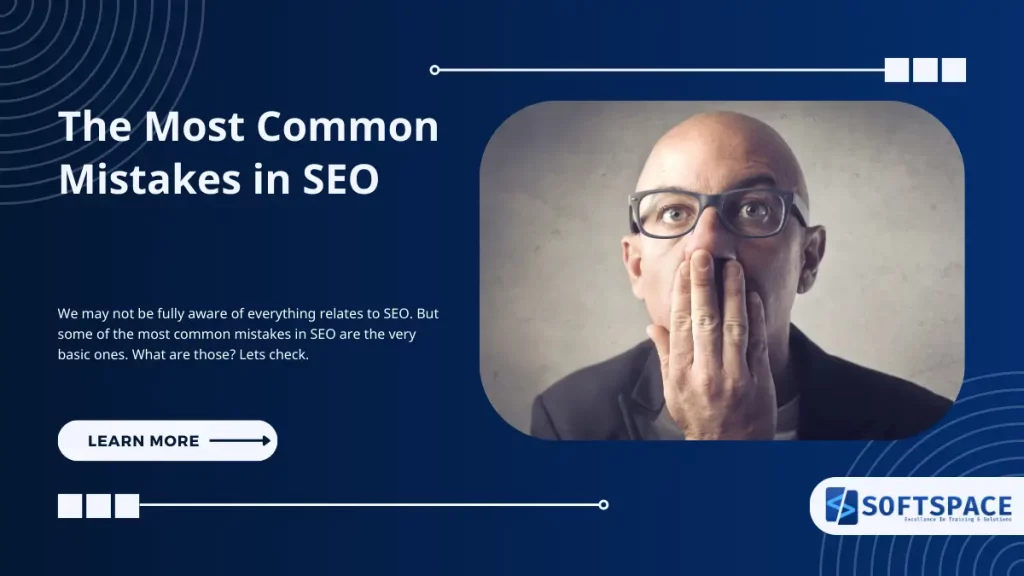Digital marketing evolves at breakneck speed, yet countless websites still cling to outdated SEO practices that quietly sabotage their rankings. As search algorithms grow more sophisticated in 2024, even seasoned marketers find themselves caught in optimization traps that worked five years ago but now spell disaster for visibility.
From keyword stuffing masquerading as “optimization” to neglecting the critical role of user experience signals, these persistent common mistakes in SEO can cost you more than just rankings – they’re leaving valuable traffic and conversions on the table. In this guide, we’ll cut through the noise and expose the most common SEO pitfalls that could be holding your website back, along with actionable solutions that align with search engines’ latest priorities.

The Most Common Mistakes in SEO
One of the most common mistakes in SEO is neglecting keyword research, leading to targeting irrelevant or overly competitive keywords. Additionally, many websites fail to optimise for mobile users, even though mobile traffic accounts for a significant portion of web usage. Ignoring technical SEO, such as slow page load times or broken links, can also hurt rankings and user experience.
Another frequent error is neglecting to regularly update content, which can lead to outdated information and reduced relevance. Lastly, overloading pages with keywords, known as keyword stuffing, can harm rankings, as search engines now prioritise natural, user-friendly content.
Here we have listed some of the common mistakes in SEO that you MUST AVOID.
Ignoring Proper Keyword Research
Effective SEO starts with targeted keyword research. A common mistake is to skip or rush through this stage, resulting in poorly chosen keywords that don’t align with what users are searching for. This can lead to targeting highly competitive keywords that are difficult to rank for or choosing keywords with low search volume that don’t bring much traffic.
To avoid this, it’s essential to conduct thorough keyword research to understand both popular and long-tail keywords that match user intent. Using tools like Google’s Keyword Planner or Ahrefs can provide insights into search volume, competition, and relevance, making it easier to pick the right keywords for your content and strategy.
Misusing Link-Building Practices
Link building is a powerful SEO tool, but it requires careful execution. A common misstep is using excessive reciprocal linking, where two sites agree to link to each other. While this can sometimes be effective, overdoing it or using it carelessly can lead to search engine penalties.
For instance, if you’re looking for a guide on reciprocal link building, you’ll notice that most of them often overlook the potential risks, such as diminishing the perceived value of your site to search engines and possibly leading to penalties if not managed with extreme caution.
Instead of focusing solely on reciprocal links, it’s better to develop a strategy that includes high-quality backlinks from reputable sources relevant to your industry.
Overlooking Technical SEO
Technical SEO refers to optimizing a website’s backend structure to ensure search engines can efficiently crawl and index it. Ignoring technical SEO is a common mistake that can severely impact site performance. Key technical factors include site speed, mobile-friendliness, and secure connections (SSL certificates).
A slow website can frustrate users and lead to high bounce rates, while a lack of mobile optimization can lead to poor user experience on smartphones and tablets. Secure connections (HTTPS) are also important, as search engines prioritize secure sites in search rankings. Regularly auditing technical aspects with tools like Google Search Console can help identify issues early, allowing for prompt fixes that improve site functionality.
Focussing solely on Search Engines, Not Users
SEO strategies often focus too heavily on search engines and overlook the importance of user experience. This approach can lead to keyword-stuffed content, irrelevant pages, and poor navigation—all of which detract from the user’s experience. A successful SEO strategy should balance the needs of search engines with those of the audience.
Prioritizing high-quality, user-friendly content that addresses the audience’s questions or problems not only improves user engagement but also aligns with search engines’ focus on content relevance. Creating a site that’s easy to navigate, with intuitive layouts and engaging content, is essential for building trust and improving rankings.
Keyword Stuffing
While keywords are important, stuffing them into content can hurt SEO rather than help it. Keyword stuffing involves overusing targeted keywords in a way that sounds unnatural, disrupting the content’s flow. This not only makes the text difficult to read but can also lead to penalties from search engines that flag the content as spammy.
A better approach is to use keywords naturally and strategically, ensuring they fit smoothly within the context. Secondary keywords and related phrases can also help enhance relevance without compromising readability. High-quality, engaging content is always more effective for SEO than keyword-dense, unreadable text.
Not Optimizing for Mobile
Mobile optimization is no longer optional—it’s a necessity. With an increasing number of users accessing websites via mobile devices, a site that isn’t mobile-friendly risks losing a significant portion of its audience. Mobile optimization means ensuring that your website design adapts to various screen sizes, providing a seamless user experience across devices.
Google also prioritizes mobile-friendly websites in search rankings, so a lack of mobile optimization can negatively impact SEO performance. Simple steps like using responsive design, compressing images for faster loading, and ensuring buttons are easy to tap can make a significant difference in both user satisfaction and search rankings.
Creating Low-Quality Content
Content quality is one of the most influential factors in SEO, yet many still overlook its importance. Publishing low-quality or “thin” content that adds little value to the user’s experience can harm a site’s authority and search engine ranking. Search engines prioritize informative, well-structured, and engaging content that meets user needs.
It’s essential to focus on creating in-depth articles, guides, or blog posts that answer specific questions and provide valuable insights. High-quality content encourages longer visits, and more engagement, and increases the likelihood of earning backlinks, all of which benefit SEO.
AI Content Misuse
Whilst AI tools can boost content creation efficiency, their misuse poses significant risks to your SEO strategy. Search engines, particularly Google, are becoming increasingly adept at identifying AI-generated content that lacks human touch.
The key isn’t to avoid AI altogether, but to use it wisely. Ensure all AI content undergoes thorough human editing, incorporating personal experiences, industry expertise, and original insights. Prioritise E-E-A-T (Experience, Expertise, Authoritativeness, Trustworthiness) by including expert quotes, real case studies, and current statistics.
Remember, AI should enhance your content creation process, not replace the authentic human perspective that readers—and search engines—value.
Ignoring Local SEO
For businesses with physical locations or those that serve specific regions, local SEO is a critical yet often neglected aspect. Optimizing for local search involves creating content tailored to local interests, using location-specific keywords, and ensuring the business appears in local search results.
Local SEO practices like optimizing Google My Business profiles, encouraging positive reviews, and adding location information on the website can significantly increase visibility for regionally targeted audiences. Ignoring local SEO means missing out on potential customers who are actively searching for nearby services, impacting both traffic and revenue.
Core Werb Vitals Ignorance
Core Web Vitals have become crucial ranking signals, yet many websites continue to neglect these essential performance metrics. LCP (Largest Contentful Paint) should load within 2.5 seconds—slow-loading hero images or banner content can severely impact your scores. First Input Delay (FID) measures interactivity; anything above 100ms frustrates users and harms rankings.
Cumulative Layout Shift (CLS) needs to stay below 0.1 to prevent those annoying layout jumps that occur when elements load unexpectedly. Regular monitoring via Google Search Console is vital; these warnings aren’t mere suggestions but rather critical indicators of your site’s health. Optimising these metrics isn’t just about pleasing search engines—it’s about delivering the smooth, professional experience your visitors expect.
Failing to Track and Analyze Results
A common mistake in SEO is implementing strategies without tracking their effectiveness. Monitoring performance through analytics tools allows SEOs to understand what is working and what needs adjustment. Metrics like organic traffic, bounce rates, and click-through rates provide insights into user behaviour and reveal potential areas for improvement.
Tools like Google Analytics and Google Search Console are essential for measuring the success of SEO efforts and making data-driven decisions. Regularly reviewing and analyzing these metrics enables continuous optimization and refinement of SEO strategies, keeping the website aligned with user interests and search engine criteria.
Relying on Outdated Tactics
SEO is a constantly evolving field, with search engines frequently updating algorithms to improve user experience and combat manipulative practices. Relying on outdated tactics, such as over-optimized anchor text, excessive use of exact-match keywords, or link schemes, can backfire. These practices were once effective but now carry the risk of penalties, reducing a site’s visibility and reputation.
Staying updated with the latest SEO trends, best practices, and Google’s evolving guidelines is essential to remain competitive. Regularly revisiting and updating SEO strategies ensures they remain effective and relevant in the current digital landscape.
Conclusion
In conclusion, building a successful SEO strategy requires awareness of common pitfalls and a commitment to best practices that prioritize both search engine requirements and user experience. Avoiding issues like mobile inaccessibility, poor content quality, and outdated tactics can significantly enhance a site’s performance and relevance.
By continuously refining SEO efforts, tracking results, and adapting to new trends, businesses can achieve a sustainable online presence that attracts traffic, improves rankings, and fosters user engagement.

13+ Yrs Experienced Career Counsellor & Skill Development Trainer | Educator | Digital & Content Strategist. Helping freshers and graduates make sound career choices through practical consultation. Guest faculty and Digital Marketing trainer working on building a skill development brand in Softspace Solutions. A passionate writer in core technical topics related to career growth.



